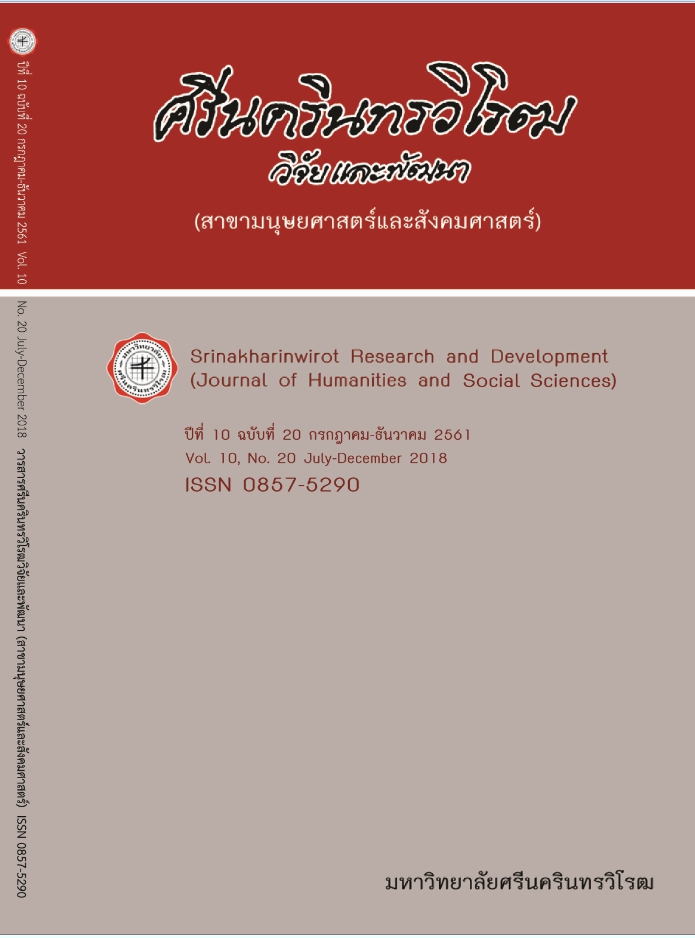อิทธิพลของนวัตกรรมองค์การต่อการเติบโตทางธุรกิจผ่านการจัดการทรัพยากรมนุษย์ และการพัฒนาผลิตภัณฑ์ใหม่ THE EFFECT OF INNOVATION-BASED ORIENTATION ON BUSINESS GROWTH THROUGH HUMAN RESOURCES MANAGEMENT AND NEW PRODUCT DEVELOPMENT
Keywords:
Business Growth, Human Resources Management, Innovation-Based, Product DevelopmentAbstract
An organization’s innovation-based orientation creates innovation and is important to business growth. Development of human resources and new products are determined in terms of mediation between knowledge base and business growth.The subjects here consist of local firms from various industries operating in Thailand.
The Structural Equation Model (SEM) is used to discover the link between variables in the framework and two mediators. The results indicate that knowledge base has a significant effect on both human resources management and new product development. Consequently, these two wield great influence on business growth.
Downloads
References
[2] E. Lacasa, J. L. Santolaya, L. Fuentes; and A. C. Majarena. (2015). Implementing Sustainability Criteria in Product Development. Procedia Engineering. 132: 1029-1036.
[3] J. Andersén. (2011). Strategic resources and firm performance. Management Decision. 49: 87-98.
[4] M. A. Chilton; and J. M. Bloodgood. (2010). Adaption-innovation theory and knowledge use in organizations. Management Decision. 48: 1159-1180.
[5] M.-S. Castaño, M.-T. Méndez; and M.-Á. Galindo. (2016). Innovation, internationalization and business-growth expectations among entrepreneurs in the services sector. Journal of Business Research. 69: 1690-1695.
[6] M. E. B. Herrera. (2016). Innovation for impact: Business innovation for inclusive growth. Journal of Business Research. 69: 1725-1730.
[7] A. Luqmani, M. Leach; and D. Jesson. (n.d.). Factors behind sustainable business innovation: The case of a global carpet manufacturing company. Environmental Innovation and Societal Transitions.
[8] Z. Liao. (2016). Temporal cognition, environmental innovation, and the competitive advantage of enterprises. Journal of Cleaner Production. 135: 1045-1053.
[9] N. N. A. Aziz; and S. Samad. (2016). Innovation and Competitive Advantage: Moderating Effects of Firm Age in Foods Manufacturing SMEs in Malaysia. Procedia Economics and Finance. 35: 256-266.
[10] T. Lay Hong, C. Boon Cheong; and H. Syaiful Rizal. (2016). Service Innovation in Malaysian Banking Industry towards Sustainable Competitive Advantage through Environmentally and Socially Practices. Procedia - Social and Behavioral Sciences. 224: 52-59.
[11] K. Z. Zhou; and F. Wu. (2010). Technological capability, strategic flexibility, and product innovation. Strategic Management Journal. 31: 547-561.
[12] T. Savino, A. Messeni Petruzzelli; and V. Albino. (2015). Search and recombination process to innovate: A review of the empirical evidence and a research agenda. International Journal of Management Reviews.
[13] R. Aryanto, A. Fontana; and A. Z. Afiff. (2015). Strategic human resource management, innovation capability and performance: An Empirical Study in Indonesia Software Industry. Procedia-Social and Behavioral Sciences. 211: 874-879.
[14] M. Abramovitz. (1986). Catching up, forging ahead, and falling behind. The Journal of Economic History. 46: 385-406.
[15] P. F. Drucker. (1987). The Discipline of Innovation. Harvard Business Review. 2: 484-485.
[16] A. La Rocca, P. Moscatelli, A. Perna; and I. Snehota. (2016). Customer involvement in new product development in B2B: The role of sales. Industrial Marketing Management. 58: 45-57.
[17] T. Woschke; and H. Haase. (2016). Enhancing new product development capabilities of small- and medium-sized enterprises through managerial innovations. The Journal of High Technology Management Research. 27: 53-64.
[18] J. Barney. (1991). Firm resources and sustained competitive advantage. Journal of Management. 17: 99-120.
[19] S. Zhao; and J. Du. (2012). Thirty-two years of development of human resource management in China: Review and prospects. Human Resource Management Review. 22: 179-188.
[20] C. Grimpe; and U. Kaiser. (2010). Balancing internal and external knowledge acquisition: the gains and pains from R&D outsourcing. Journal of management studies. 47: 1483-1509.
[21] K. Laursen. (2012). Keep searching and you’ll find: what do we know about variety creation through firms’ search activities for innovation?. Industrial and Corporate Change. 21: 1181-1220.
[22] A. M. Subramanian, Y. R. Choi, S.-H. Lee; and C.-C. Hang. (2016). "Linking technological and educational level diversities to innovation performance. The Journal of Technology Transfer. 41: 182-204.
[23] M. Bitzer, M. Vielhaber; and F. Dohr. (2014). From Product Development to Technology Development. Procedia CIRP. 21: 247-251.
[24] C. I. Davidson, H. S. Matthews, C. T. Hendrickson, M. W. Bridges, B. R. Allenby, J. C. Crittenden; et al. (2007). Adding sustainability to the engineer’s toolbox: a challenge for engineering educators. Environmental Science and Technology. 41: 4847-4850.
[25] J. Kettunen, Y. Grushka-Cockayne, Z. Degraeve; and B. De Reyck. (2015). New product development flexibility in a competitive environment. European Journal of Operational Research. 244: 892-904.
[26] Y. Suharyanti, Subagyo, N. A. Masruroh; and I. Bastian. (2015). The Scheme of Product Development Process as a Trigger to Product Success: A Theoretical Framework. Procedia Manufacturing. 4: 46-53.
[27] P. D. Cousins, B. Lawson, K. J. Petersen; and R. B. Handfield. (2011). Breakthrough scanning, supplier knowledge exchange, and new product development performance. Journal of Product Innovation Management. 28: 930-942.
[28] N. Gautam; and N. Singh. (2008). Lean product development: Maximizing the customer perceived value through design change (redesign). International Journal of Production Economics. 114: 313-332.
[29] E. J. O. Luttikhuis, J. de Lange, E. Lutters; and R. ten Klooster. (2015). Evolving Product Information in Aligning Product Development Decisions across Disciplines. Procedia CIRP. 29: 573-578.
[30] R. Morck; and B. Yeung. (2003). Agency problems in large family business groups. Entrepreneurship Theory and Practice. 27: 367-382.
[31] A. De Massis, F. Frattini; and U. Lichtenthaler. (2013). Research on technological innovation in family firms: Present debates and future directions. Family Business Review. 26: 10-31.
[32] Y. R. Choi, S. A. Zahra, T. Yoshikawa; and B. H. Han. (2015). Family ownership and R&D investment: The role of growth opportunities and business group membership. Journal of Business Research. 68: 1053-1061.
[33] H. Dahles; and T. P. Susilowati. (2015). Business resilience in times of growth and crisis. Annals of Tourism Research. 51: 34-50.
Downloads
Published
How to Cite
Issue
Section
License
Srinakharinwirot Research and Development Journal of Humanities and Social Sciences is licensed Under a Creative Commons Attribution-NonCommercial-NoDerivs 4.0 International (CC-BY-NC-ND 4.0) License, Unless Otherwise Stated. Please Read Journal Policies Page for More Information on Open Access, Copyright and Permissions.



